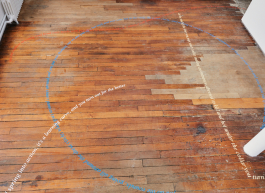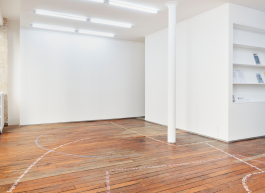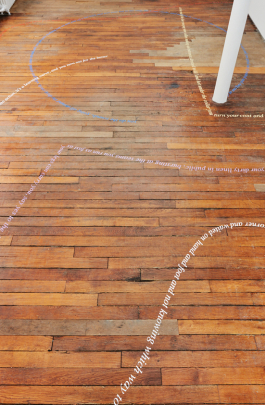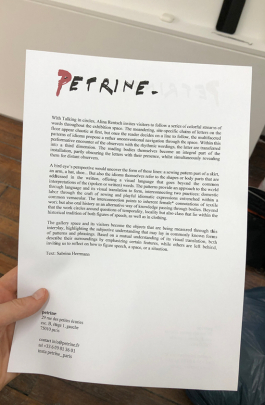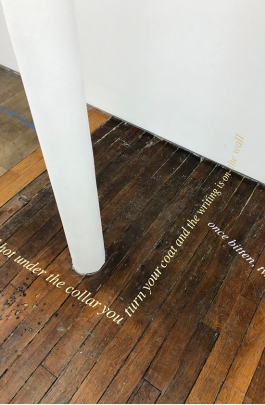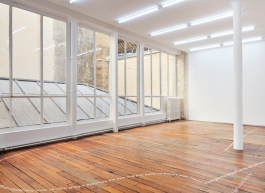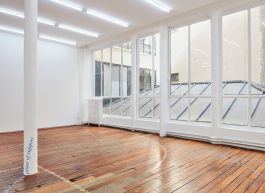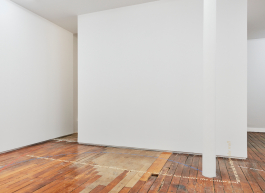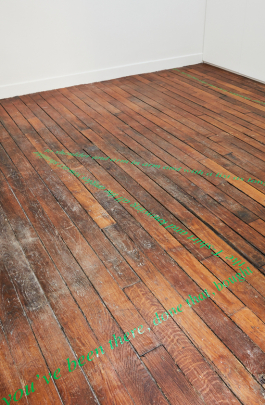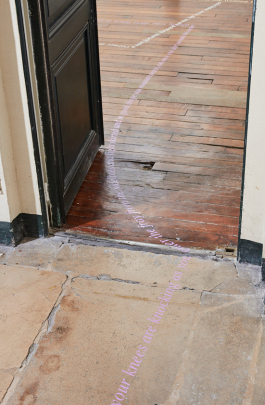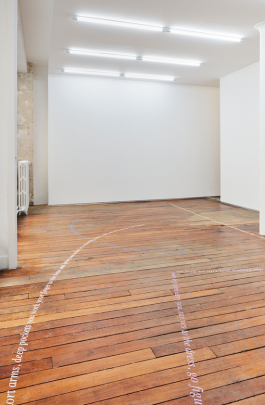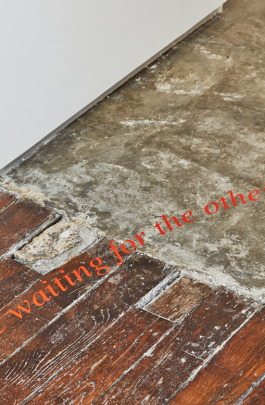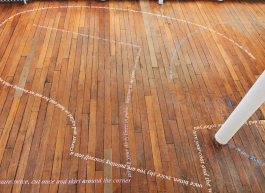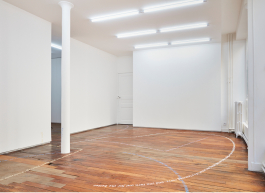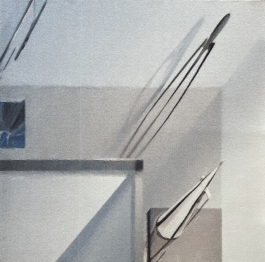
Alina Rentsch lives and works in Berlin. Her practice revolves around language, communication, and the interplay between text, image, and body. She works through space as a fundamental condition, investigating the structures and politics of exhibitions, text distribution, and reception, while integrating viewer movement as an essential element of her projects. Her work frequently takes the form of site-specific installations, printed matter, or ephemeral situations, often experimenting with alternative display formats and stage-like settings that critically reflect on institutional frameworks. She holds a BFA from Weißensee Academy of Art, Berlin, and an MFA from Konstfack, Stockholm. She has exhibited at Frieze, London; Petrine, Paris; Linienstraße, Düsseldorf; Vapaan Taiteen Tila, Helsinki; Index–The Swedish Contemporary Art Foundation, Stockholm; B7L9 Art Station at Kamel Lazaar Foundation, Tunis; Konsthall C, Stockholm; Studio Giardini, IASPIS program during the 59th Venice Biennale, Venice; Kunstraum Kreuzberg/Bethanien, Berlin; and other venues. Rentsch is represented by Petrine, Paris.
Booth
PF400 Velour, 580 x 430 cm
LED panel, vinyl film, 200 x 60 x 15 cm
Booth transforms the corner space at Frieze London into a site of distortion and shifting perspectives. A printed carpet creates an anamorphic illusion of an imagined sub-level that resolves only from one precise point of view. Above, a single lamp voices an excerpt from her fair proposal, turning the booth into both a commercial metric and an image-producing device. Drawing on seventeenth-century perspective boxes, economic thresholds, and the shifting position of the viewer, Booth moves between image and infrastructure, illusion and document.
The installation unfolds through language-like markers that point to trade, logistics, and functionality while invoking fiction, illusion, and grammar. Central to this vocabulary is the kitchen, reimagined as a metaphor for translation: the processing of raw material into consumable form, whether culinary, linguistic, or economic. It also recalls the kitchen as a social space of gathering and speech, in contrast to the formal language of the fair booth. Inserted into the fair’s commercial logic, this domestic infrastructure unsettles the line between private and public, utility and display. In doing so, Booth reveals the fair architecture not simply as a container, but as a stage where language, economy, and perception are continuously translated into image.
The presentation is accompanied by A Private Life, a text by Angharad Williams, adapted for the fair from her 2021 piece The Last Testament and Will of Me. Find the brochure and full text here. Graphic design by Janis Gildein.
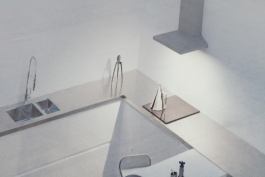
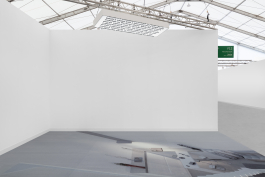
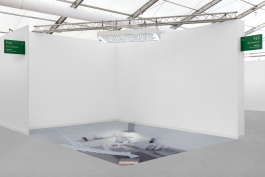
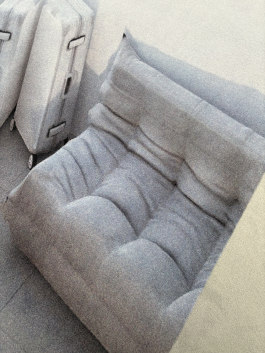
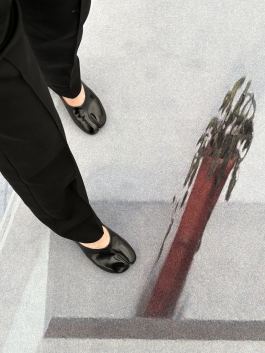
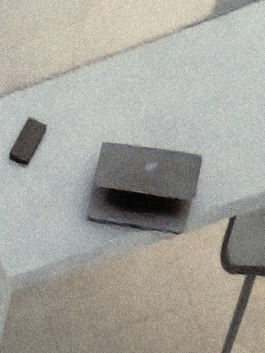
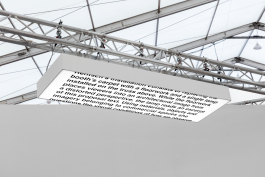
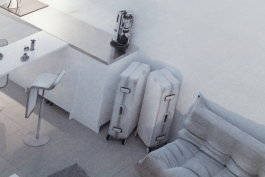
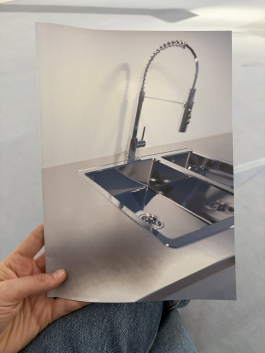
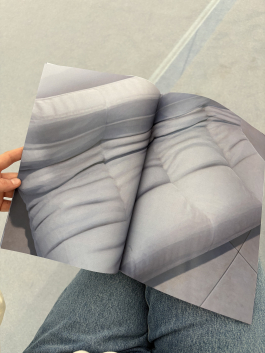
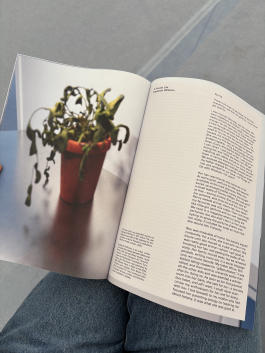
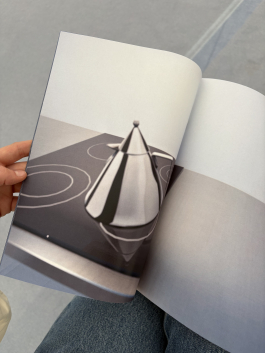
Fear not, dear shopper, for there's a way
curated by Franca Zitta
Installation, various materials
Fear not, dear shopper, for there’s a way takes its starting point from the location itself: the exhibition space Linienstrasse in Düsseldorf, with its historical context and spatial structure. The exhibition unfolds across three successive rooms, evoking a dramaturgy akin to a three-act play. Once a grocery store, the space reimagines visitors as shoppers, moving through a staged experience. In the first act, visitors encounter heat maps – tools typically used to evaluate customer behavior in commercial environments. The second act offers an escalation, namely a distorted reflection of the viewer. In the final act, a teleprompter-like voice describes both the immediate situation and the imagined desires of a disappointed shopper who ultimately arrives at an absence – a stage where expectation lingers but resolution never fully materializes.
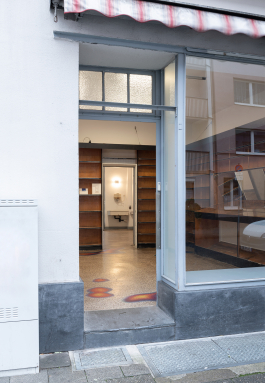
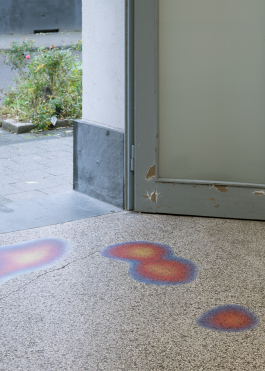
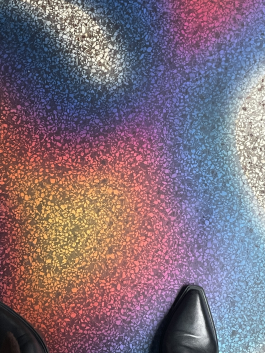
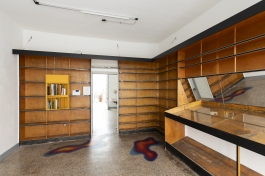
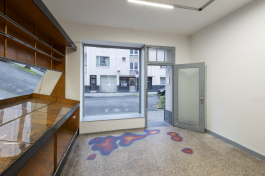
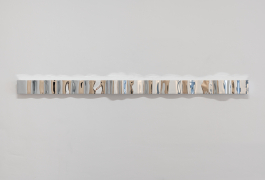
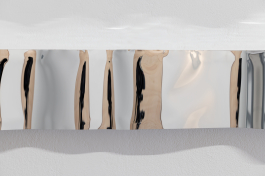
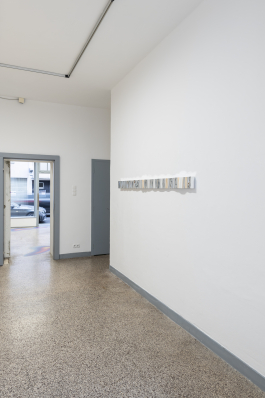
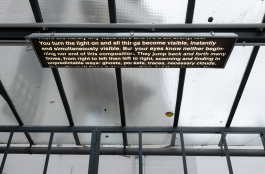
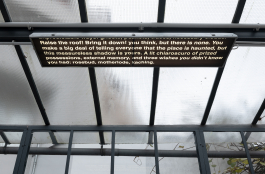
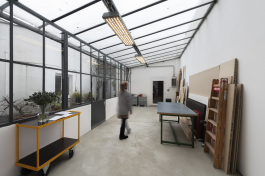
Also a hair seems to have crept in
Installation, various materials
The exhibition comprises new works that take the gallery space itself as subject, exploring the relationship between the objects and their physical environment. Over the course of the past year the gallery space was documented with a book scanner, a technology that suggests automatic generation of objective reproduction. The scans however resulted in a contrary image: bearing traces of glitches, faults, disturbances, things that are fragile, changeable, manipulable. Embracing these traces opens up another methodology of creation, something that cannot be produced again and/or intentionally. A sociological approach to space puts forth that it is neither object or vessel, but rather a means of production. Enacted through social processes and conventions of use, they define the modes of such production. If before the space appeared empty, the doubling, reproducing, and fragmenting turns this perceived emptiness into objects, rendering what is on view into goods, setting off a continuous process of transmutations in a commercial setting.
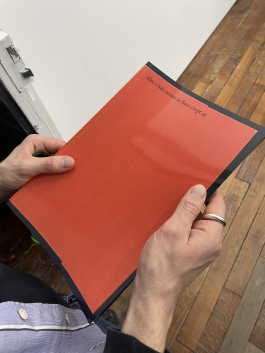
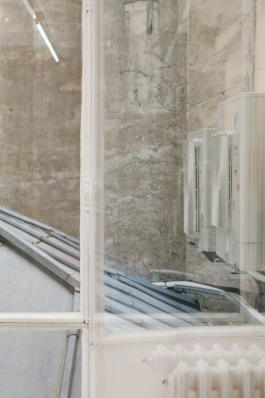
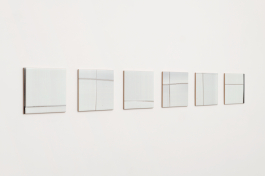
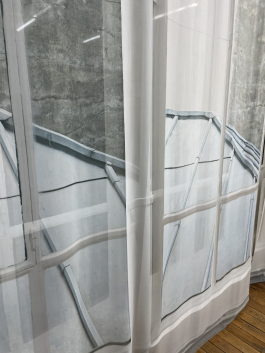
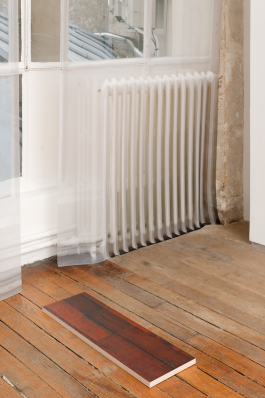
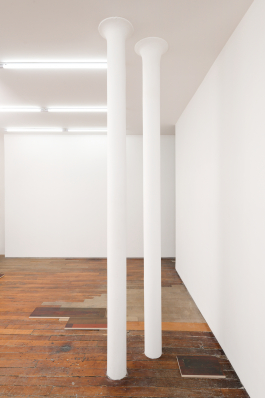
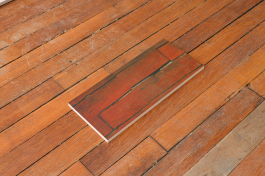
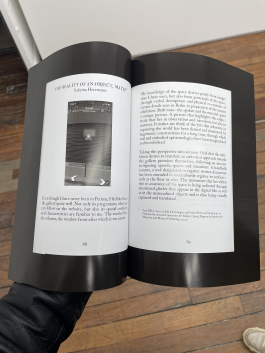
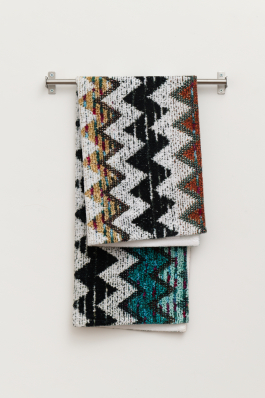
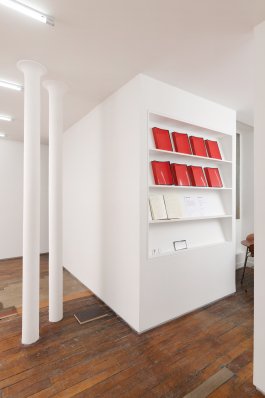
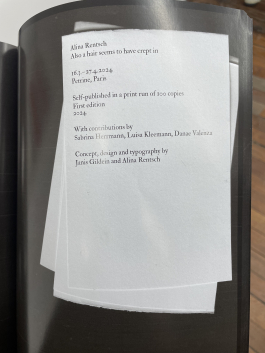
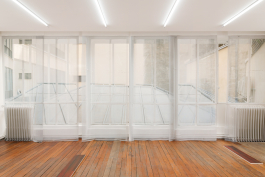
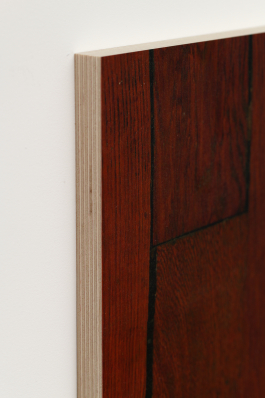
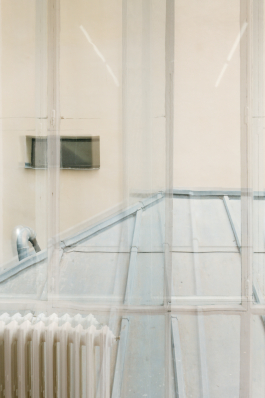
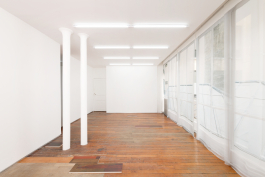
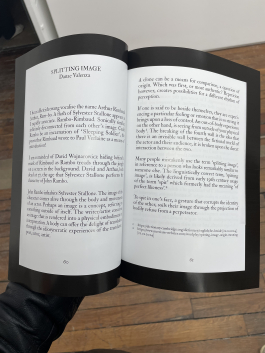
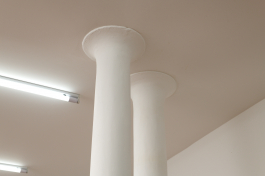
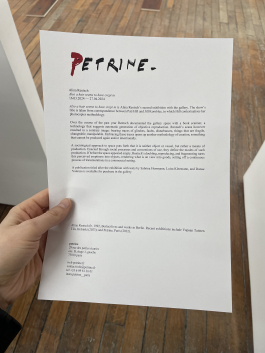
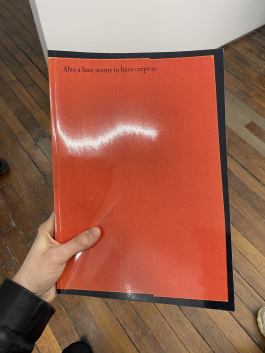
Great Weather
Sublimation print on textile (420 cm x 140 cm)
Since the Renaissance, ceramic figurines have been used as decoration for ceremonial tables, intended to suggest topics of conversation for guests. These conversation pieces often depicted taboo or provocative scenes and were designed to spark discussion, while also allowing guests to gauge one another’s knowledge, taste, or cultural standing. Great Weather gathers these objects on a table, on which the objects themselves enter into dialogue with each other. Grouped and removed from their customary context, the work questions their legibility today and proposes an alternative way of looking at these pieces, creating an environment conducive to exchange and conviviality within a space that was not originally aligned with such qualities.
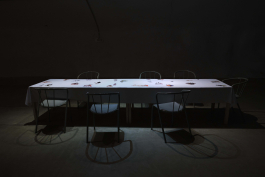
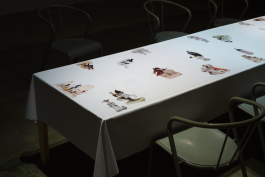
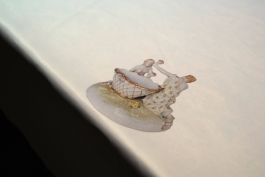
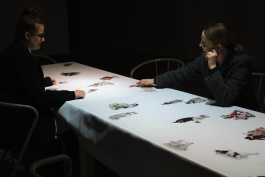
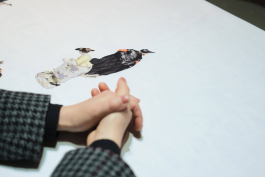
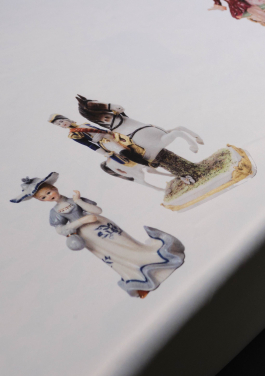
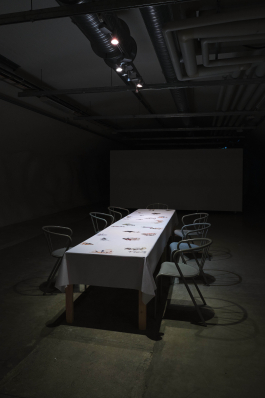
Talking in circles
Glossy vinyl foil installed on floor, dimensions variable
Talking in circles invites visitors to follow a series of colorful streams of words throughout the exhibition space. The meandering, site-specific chains of letters on the floor consist of idiomatic expressions that appear chaotic at first, but once the reader decides on a line to follow, the multifaceted patterns reveal not only an unconventional navigation through the space, but also the underlying structures, absurdities, and patterns within these language images. In this performative encounter of the observers with the rhythmic wordings, the latter are transferred into a third dimension. The reading bodies themselves become an integral part of the installation, partly obscuring the letters with their presence, whilst simultaneously revealing them for distant observers.
Scroll to top
© 2025 All Rights Reserved.

Alina Rentsch lives and works in Berlin. Her practice revolves around language, communication, and the interplay between text, image, and body. She works through space as a fundamental condition, investigating the structures and politics of exhibitions, text distribution, and reception, while integrating viewer movement as an essential element of her projects. Her work frequently takes the form of site-specific installations, printed matter, or ephemeral situations, often experimenting with alternative display formats and stage-like settings that critically reflect on institutional frameworks. She holds a BFA from Weißensee Academy of Art, Berlin, and an MFA from Konstfack, Stockholm. She has exhibited at Frieze, London; Petrine, Paris; Linienstraße, Düsseldorf; Vapaan Taiteen Tila, Helsinki; Index–The Swedish Contemporary Art Foundation, Stockholm; B7L9 Art Station at Kamel Lazaar Foundation, Tunis; Konsthall C, Stockholm; Studio Giardini, IASPIS program during the 59th Venice Biennale, Venice; Kunstraum Kreuzberg/Bethanien, Berlin; and other venues. Rentsch is represented by Petrine, Paris.
Booth
PF400 Velour, 580 x 430 cm
LED panel, vinyl film, 200 x 60 x 15 cm
Booth transforms the corner space at Frieze London into a site of distortion and shifting perspectives. A printed carpet creates an anamorphic illusion of an imagined sub-level that resolves only from one precise point of view. Above, a single lamp voices an excerpt from her fair proposal, turning the booth into both a commercial metric and an image-producing device. Drawing on seventeenth-century perspective boxes, economic thresholds, and the shifting position of the viewer, Booth moves between image and infrastructure, illusion and document.
The installation unfolds through language-like markers that point to trade, logistics, and functionality while invoking fiction, illusion, and grammar. Central to this vocabulary is the kitchen, reimagined as a metaphor for translation: the processing of raw material into consumable form, whether culinary, linguistic, or economic. It also recalls the kitchen as a social space of gathering and speech, in contrast to the formal language of the fair booth. Inserted into the fair’s commercial logic, this domestic infrastructure unsettles the line between private and public, utility and display. In doing so, Booth reveals the fair architecture not simply as a container, but as a stage where language, economy, and perception are continuously translated into image.
The presentation is accompanied by A Private Life, a text by Angharad Williams, adapted for the fair from her 2021 piece The Last Testament and Will of Me. Find the brochure and full text here. Graphic design by Janis Gildein.



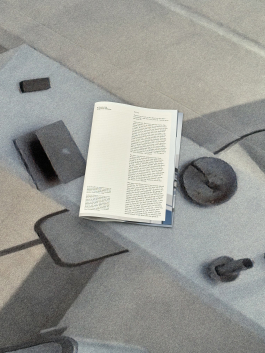









Fear not, dear shopper, for there's a way
curated by Franca Zitta
Installation, various materials
Fear not, dear shopper, for there’s a way takes its starting point from the location itself: the exhibition space Linienstrasse in Düsseldorf, with its historical context and spatial structure. The exhibition unfolds across three successive rooms, evoking a dramaturgy akin to a three-act play. Once a grocery store, the space reimagines visitors as shoppers, moving through a staged experience. In the first act, visitors encounter heat maps – tools typically used to evaluate customer behavior in commercial environments. The second act offers an escalation, namely a distorted reflection of the viewer. In the final act, a teleprompter-like voice describes both the immediate situation and the imagined desires of a disappointed shopper who ultimately arrives at an absence – a stage where expectation lingers but resolution never fully materializes.

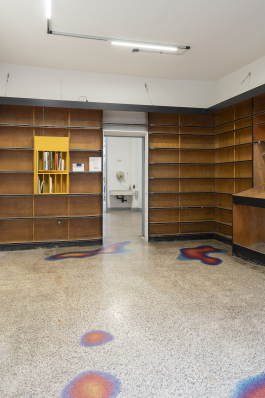

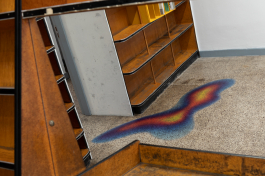

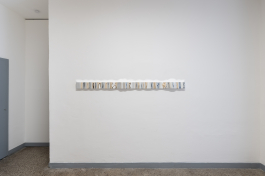



Also a hair seems to have crept in
Installation, various materials
The exhibition comprises new works that take the gallery space itself as subject, exploring the relationship between the objects and their physical environment. Over the course of the past year the gallery space was documented with a book scanner, a technology that suggests automatic generation of objective reproduction. The scans however resulted in a contrary image: bearing traces of glitches, faults, disturbances, things that are fragile, changeable, manipulable. Embracing these traces opens up another methodology of creation, something that cannot be produced again and/or intentionally. A sociological approach to space puts forth that it is neither object or vessel, but rather a means of production. Enacted through social processes and conventions of use, they define the modes of such production. If before the space appeared empty, the doubling, reproducing, and fragmenting turns this perceived emptiness into objects, rendering what is on view into goods, setting off a continuous process of transmutations in a commercial setting.
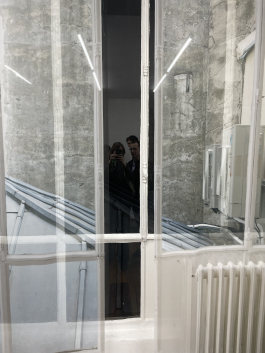




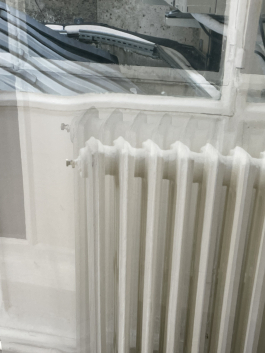





Great Weather
Sublimation print on textile (420 cm x 140 cm)
Since the Renaissance, ceramic figurines have been used as decoration for ceremonial tables, intended to suggest topics of conversation for guests. These conversation pieces often depicted taboo or provocative scenes and were designed to spark discussion, while also allowing guests to gauge one another’s knowledge, taste, or cultural standing. Great Weather gathers these objects on a table, on which the objects themselves enter into dialogue with each other. Grouped and removed from their customary context, the work questions their legibility today and proposes an alternative way of looking at these pieces, creating an environment conducive to exchange and conviviality within a space that was not originally aligned with such qualities.





Talking in circles
Glossy vinyl foil installed on floor, dimensions variable
Talking in circles invites visitors to follow a series of colorful streams of words throughout the exhibition space. The meandering, site-specific chains of letters on the floor consist of idiomatic expressions that appear chaotic at first, but once the reader decides on a line to follow, the multifaceted patterns reveal not only an unconventional navigation through the space, but also the underlying structures, absurdities, and patterns within these language images. In this performative encounter of the observers with the rhythmic wordings, the latter are transferred into a third dimension. The reading bodies themselves become an integral part of the installation, partly obscuring the letters with their presence, whilst simultaneously revealing them for distant observers.
Scroll to top
© 2025 All Rights Reserved.
